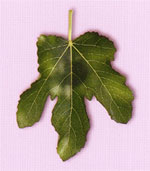|
|
|
Sweet
Figs |
|
 |
|
The Mediterranean
region produces about 1.6 million U.S. tons (1.5
million tonnes) of figs each year. Greece is the
second largest fig-producing country after Turkey.
However, with most varieties of Ficus carica,
pollination is so hazardous that the fact that they
have survived this long is bordering on a miracle.
Over the centuries, two cultivated varieties have
developed from the wild fig. According to an
intricate system these two varieties depend on each
other and on a particular type of gall wasp (Blastophaga
psenes). The edible fig bears only female flowers
with long styles, whereas the (inedible) male fig
develops female flowers with short styles (gall
flowers) and male flowers (and lignified fruits).
Both varieties flower three times a year at the same
times. The gall wasp larvae grow in the ovaries of
the gall flowers. The female wasps leave the
wooden-like fruits, already fertilized and laden
with pollen, at exactly the time when the next
generation of flowers has already opened. In their
search for a suitable ovary in which to lay their
eggs, the only flowers available to them are the
gall flowers with their short styles, because their
egglaying pipe is too short for the long styles of
the edible fig flowers. In their attempts to lay
eggs here too, however, they pollinate the edible
fig, without damaging it with their eggs. Figs are
sensitive, yields fluctuate, and their harvesting
and processing requires intensive manual labour, all
of which are reasons why many farmers have already
given up growing them. The fruits thrive only in
southern countries. |
 |
 |
 |
|
Dry Kalamata
figs are rinsed under running water to
remove and impurities. |
The cleaned,
dried figs are
placed on a conveyor belt,
where any remaining
substandard ones are removed. |
Only perfect
fruits are put into
their commercial packaging
by hand. |
|
The Fig Leaf
 |
In the 3rd century B.C., fig leaves, thrion,
were used as wrapping material. In the same way as
grape leaves are used today, they were preserved in
salt to reduce their bitter elements, so that tasty
morsels could be wrapped up in them and eaten. The
fig leaf became an important symbol of the loss of
Paradise, its use betraying to God the Father how
Adam and Eve had fallen from grace: "And the eyes of
them both were opened, and they knew that they were
naked; and they sewed fig leaves together, and made
themselves aprons." (Gen. 3:7.) Artists could not
avoid using the fig leaf when portraying this theme,
and as a consequence Adam and Eve were never seen
without hiding their modesty in this way. |
excerpts from:
"Culinaria Greece"
|
Copyright ©2001 - 2008
GreekCuisine.com. All rights reserved.
GreekCuisine.com is part of the
GoGreece.com network
2665 30th Street Suite 214, Santa Monica, CA 90405 USA
|